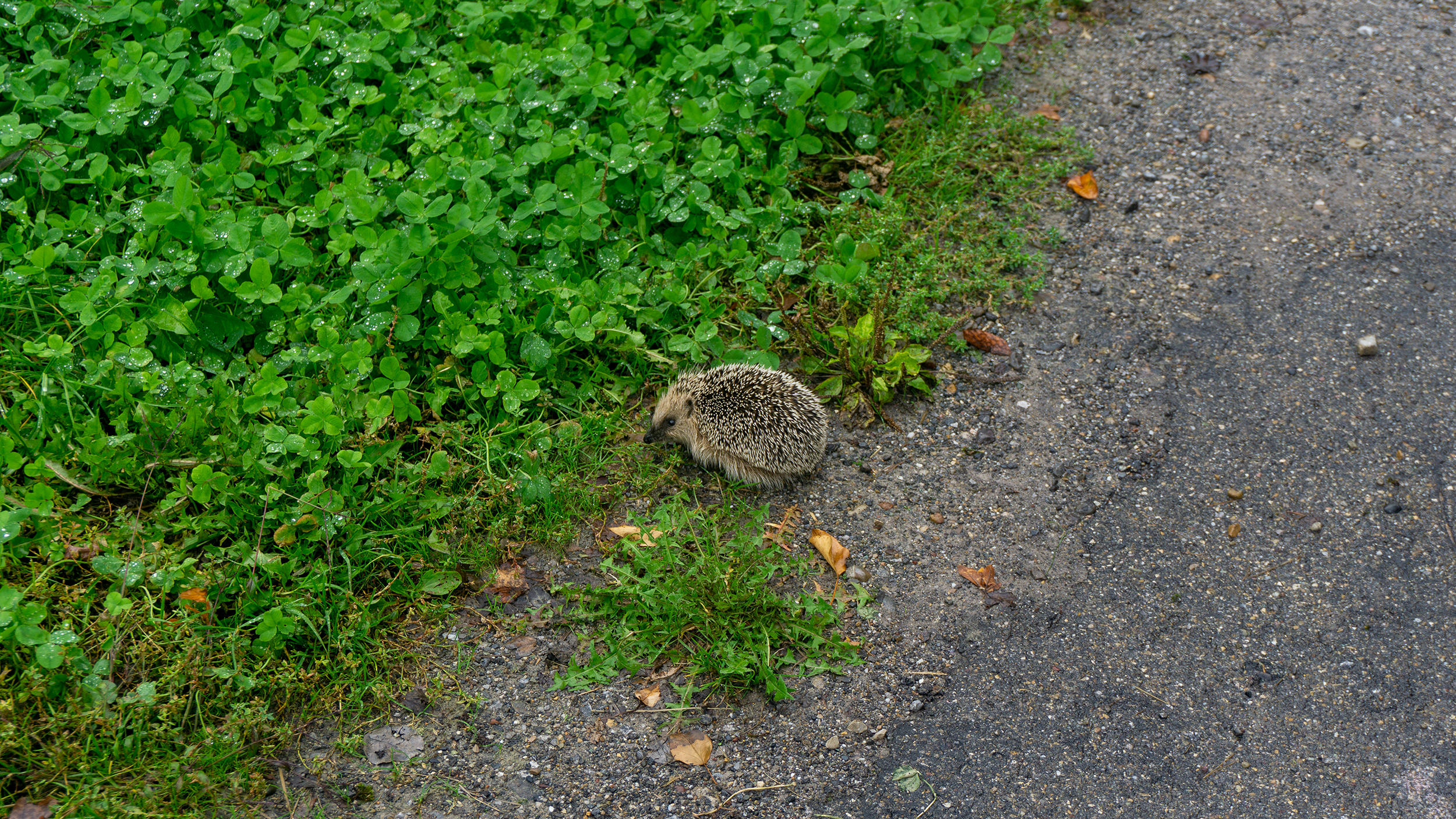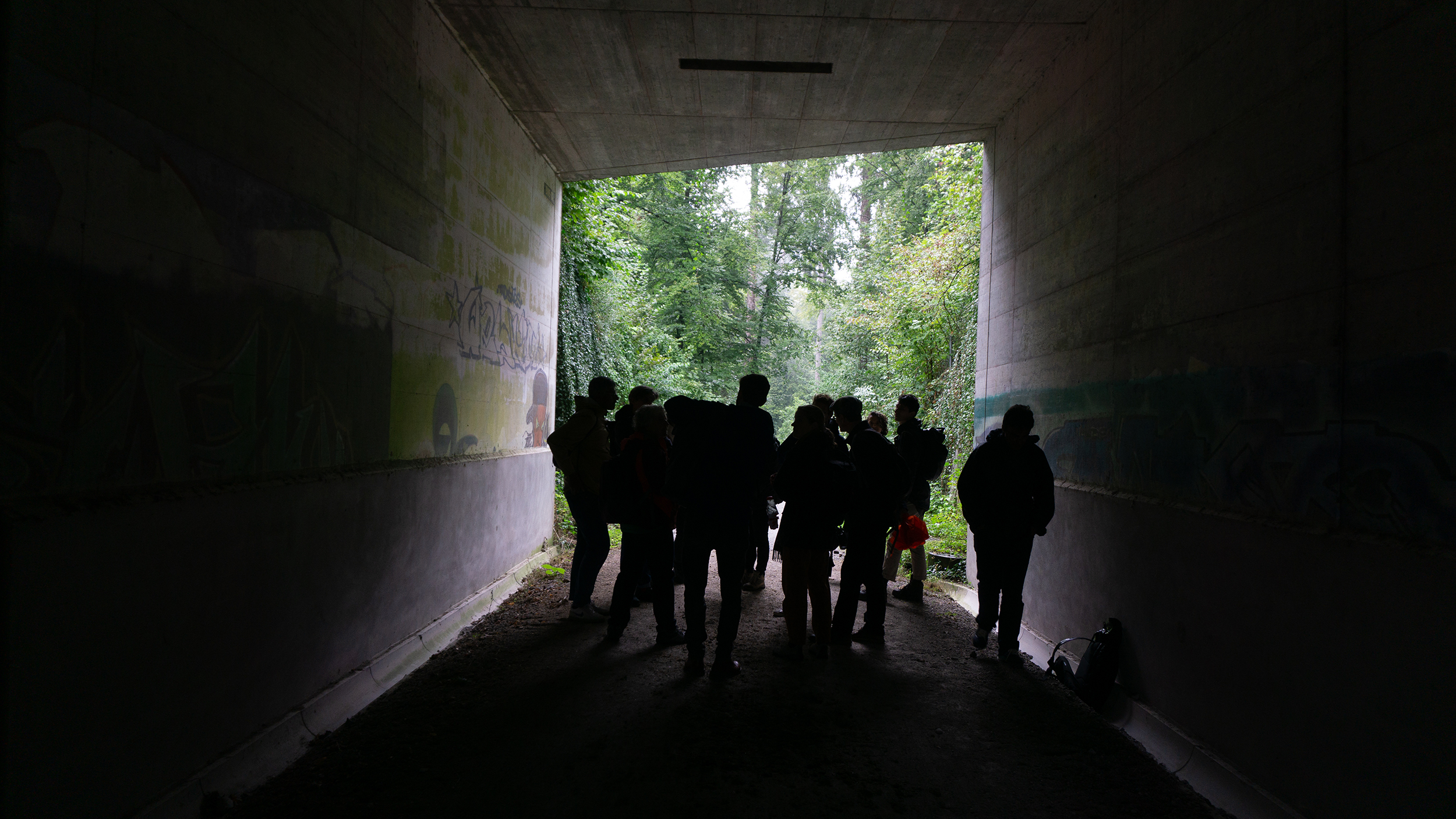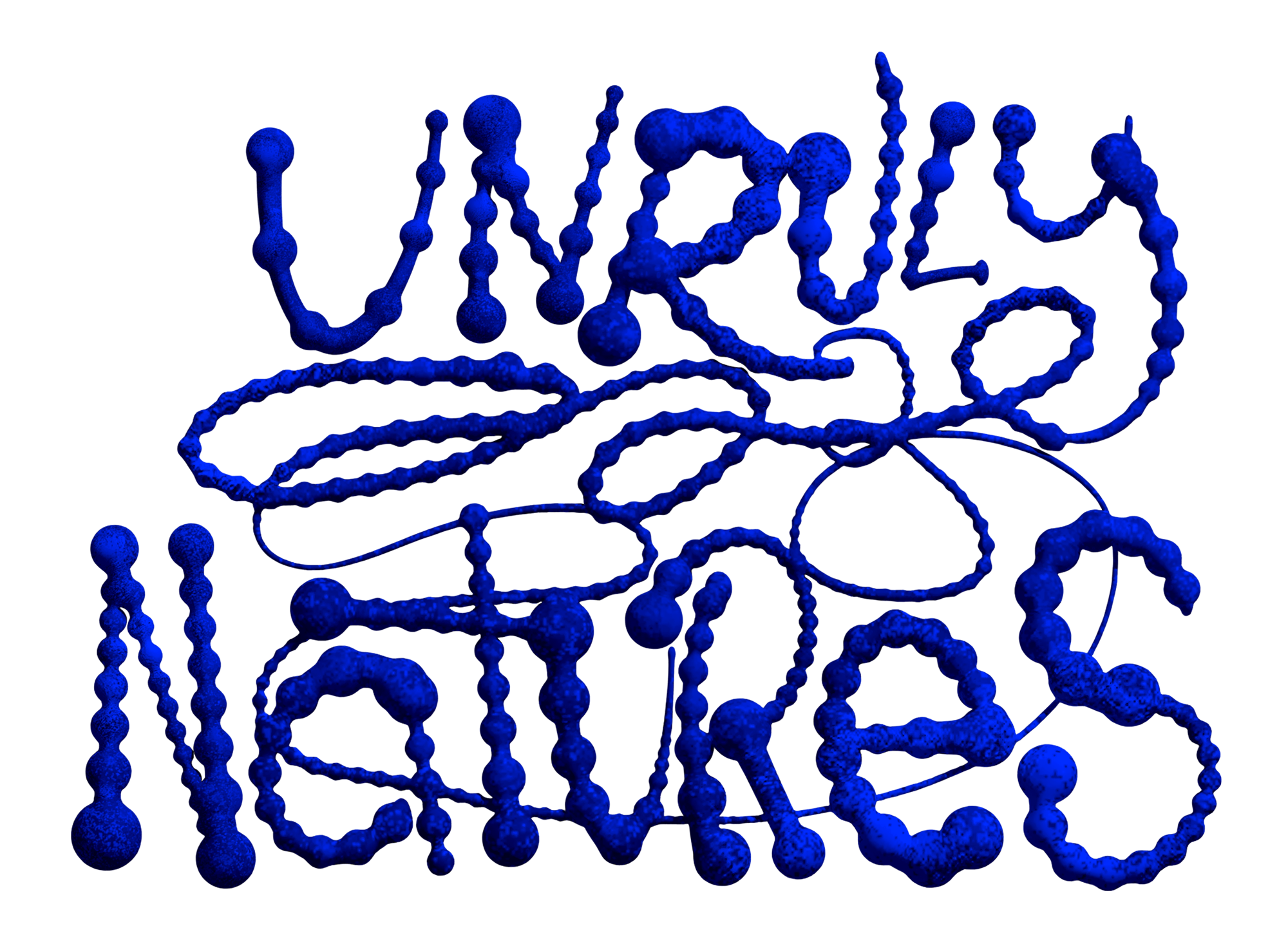Text by Rony Emmenegger
Photographs by Emiliano Guaraldo and Offshore Studio
︎
January 22, 2023
A hedgehog toddled across the gravel road at the edge of the forest Tägernauerholz when the local activist, Susanna Jenny, began to recall the forest’s recent political history.
While the animal disappeared in the understory, the activist resumed her narrative of resistance against plans of the canton of Zurich to turn the forest into a landfill for slag from the nearby incinerators in Hinwil. For the local activist, these plans are particularly threatening as they would turn the forest into a key node of waste concentration in a larger industry far beyond the cantonal boundaries.
Tägernauerholz is the largest forest in the upper Glatttal which the Canton of Zurich proposed as its favourite site for a landfill for waste disposal back in 2009. These plans provoked resistance, particularly from the local group DeponNie, of which Susanna Jenny is a leading member. The group’s name reflects its agenda: It merges the German term for landfill, “Deponie,” with the German term for never, “Nie.”
Susanna Jenny’s elaboration built a threatening scenario: If the landfill is once established, it will be complete within 10 years, its extension will be a logical consequence, and “everything will be destroyed.” As she explained: “You really have to fight. Who fights can lose. But if you don’t, you have already lost”. For its political struggle, the group has made various interventions in the legal planning process that have partially been successful. Yet, the legal paths are challenging for a small group such as DepoNie due to various legal and financial hurdles.
 A hedgehog toddling across the gravel road at the edge of the forest Tägernauerholz.
A hedgehog toddling across the gravel road at the edge of the forest Tägernauerholz.However, to avoid the struggle to end simply as a “side note” of a legal dossier at the end, her group decided to make a bit of “drama”: “We tied ourselves to trees, dressed in black and made sad faces.” Over the years, the group has organized demonstrations and tried to gain media attention – which is “a must,” as the local activist explained. In parallel, they have been attempting to mark their presence whenever possible at local events such as the yearly carnival – a powerful yet risky strategy as it turns a cultural event into a political one.
Visibility is crucial for creating and maintaining public awareness for the group and its agenda. As a most recent tactic in its ambition, the group has acquired a trailer that has subsequently served as a mobile sign of protest with the group’s yellow logo prominently placed at the trailer box. The trailer served just recently, as the local activist recalled, to mark presence in the municipal center where municipal officials met with planning authorities from the canton of Zurich.
The group draws on international conservation discourse to articulate its agenda. Quoting Dalai Lama, Susanna Jenny explained: “Our planet is our home, our only home. Where will we go if we destroy it?” The group’s argumentation has remained coherent throughout the years in the more localized struggle. They have argued that the landfill endangers the forest that requires protection.
As the activist explains, this line of argumentation is only possible due to the forest law, which gives them some legal space to intervene. However, had the landfill been planned beyond the forest, forest law would not apply, making their struggle simply a long shot. While the legal categorization of the forest opens legal space for the group’s struggle against the cantonal landfill plans, it also defines or limits the terms through which opposition can be expressed.
There is such little reason from an official perspective to protect the forest in its current form against plans to make it valuable as a landfill within a broader cycle of production and discard. The presence of protected species would make a difference, as Susanna Jenny now explains. It would probably imply additional legal hurdles for the cantonal authorities in planning. It would allow the resistance to draw on another conservation discourse to fend off cantonal plans.
And yet, the hedgehog visiting the site after our arrival at Tägernauerholz does unfortunately not quite count as an endangered species – and neither does the presence of wild boar in the forest. Whether a particular bat counts as an endangered species is currently evaluated. To abandon or settle endangered species in the forest would definitively make a difference, but the idea we now discussed remained playful thinking.
Visibility is crucial for creating and maintaining public awareness for the group and its agenda. As a most recent tactic in its ambition, the group has acquired a trailer that has subsequently served as a mobile sign of protest with the group’s yellow logo prominently placed at the trailer box. The trailer served just recently, as the local activist recalled, to mark presence in the municipal center where municipal officials met with planning authorities from the canton of Zurich.
The group draws on international conservation discourse to articulate its agenda. Quoting Dalai Lama, Susanna Jenny explained: “Our planet is our home, our only home. Where will we go if we destroy it?” The group’s argumentation has remained coherent throughout the years in the more localized struggle. They have argued that the landfill endangers the forest that requires protection.
As the activist explains, this line of argumentation is only possible due to the forest law, which gives them some legal space to intervene. However, had the landfill been planned beyond the forest, forest law would not apply, making their struggle simply a long shot. While the legal categorization of the forest opens legal space for the group’s struggle against the cantonal landfill plans, it also defines or limits the terms through which opposition can be expressed.
The problem in the first run is the forest’s legal categorization as “commercial timberland”. As such, the forest exists as a resource that is, even though not traded in a capitalist market, nevertheless an object of political and economic calculation.
There is such little reason from an official perspective to protect the forest in its current form against plans to make it valuable as a landfill within a broader cycle of production and discard. The presence of protected species would make a difference, as Susanna Jenny now explains. It would probably imply additional legal hurdles for the cantonal authorities in planning. It would allow the resistance to draw on another conservation discourse to fend off cantonal plans.
And yet, the hedgehog visiting the site after our arrival at Tägernauerholz does unfortunately not quite count as an endangered species – and neither does the presence of wild boar in the forest. Whether a particular bat counts as an endangered species is currently evaluated. To abandon or settle endangered species in the forest would definitively make a difference, but the idea we now discussed remained playful thinking.
 Visiting the Tägernauer forest with Susanna Jenny.
Visiting the Tägernauer forest with Susanna Jenny.Over the year, mobilization efforts had crystalized around a series of events, creating awareness of the looming threat and the intimate bond between the forest and the local community. Susanna Jenny explained that it is very difficult for citizens to apprehend the looming danger and become aware of the large-scale changes the project would imply if it succeeds.
Imagine, its “about 15 football fields”, the local activist explained. With the help of balloons, the group further extended the territorial struggle at Tägernauerholz also vertically: It set free balloons around the site up to the height of the planned facility with the intention of sketching the future landscape and creating a sense of the volume of the facility.
The group has also drawn on emotional registers in its ambition to strengthen the bond between the forest and its community: It recorded the “sound of biodiversity” to make the forest’s ecological dynamism tangible. Or, it taped water from the underground, which visitors could drink during one of its events. Creating a moment of political awareness allowed us to make the forest’s live supporting function not simply visible, but to realize it as an embodied experience.
Furthermore, the group used a drone to capture the forest from the birds-eye perspective. The photograph from the drone then served as a basis for a design intervention, as one group member replaced the forest with a 3D visual design of the facility and turned it into a postcard to be circulated widely. Susanna Jenny brought one of these postcards to the scene to get a visual impression of what the landfill would look like if her group’s struggle fails.
The 3D visualization with the title “clearcutting the forest” was influential as it appeared in a striking contrast to the thick and winding forest we encountered. Whether the visualization captured the threatening future accurately or not was not of such relevance, as the local activist now revealed. In her formal life as a politician, substantiating her arguments with evidence had been mandatory. For the struggle of protecting the forest, she had shifted sides: For her, it now legitimized more speculative interventions, calling politicians and authorities into duty.
As we learned, the struggle over Tägernauerholz is essentially a struggle over the very nature and valuation of the forest. For the planning authorities, the forest is suitable for the landfill due to the geological conditions at the site. As the local activist now summarized, Millions of years ago, a pothole emerged naturally that is now proposed as a suitable structure to build the waste disposal dump. The forest has to be removed, the pothole uncovered, refilled with waste, and trees again planted on top. Yet, as the local activist objected, this would no longer be a forest but simply trees. As she explained: “A forest is not the trees above, but the biodiversity below.”
As a consequence, the construction of the landfill would remove an ecosystem that cannot simply be redesigned at the end but that will be lost for good. “Reforestation will not produce a forest, but only trees,” she repeated. The struggle continues!
To make the 60’000m2 of the planned facility visible, the local forester has therefore fenced the respective area with barrier tape, which citizens could then trace to get a sense of the actual size of the project.
Imagine, its “about 15 football fields”, the local activist explained. With the help of balloons, the group further extended the territorial struggle at Tägernauerholz also vertically: It set free balloons around the site up to the height of the planned facility with the intention of sketching the future landscape and creating a sense of the volume of the facility.
The group has also drawn on emotional registers in its ambition to strengthen the bond between the forest and its community: It recorded the “sound of biodiversity” to make the forest’s ecological dynamism tangible. Or, it taped water from the underground, which visitors could drink during one of its events. Creating a moment of political awareness allowed us to make the forest’s live supporting function not simply visible, but to realize it as an embodied experience.
Furthermore, the group used a drone to capture the forest from the birds-eye perspective. The photograph from the drone then served as a basis for a design intervention, as one group member replaced the forest with a 3D visual design of the facility and turned it into a postcard to be circulated widely. Susanna Jenny brought one of these postcards to the scene to get a visual impression of what the landfill would look like if her group’s struggle fails.
The 3D visualization with the title “clearcutting the forest” was influential as it appeared in a striking contrast to the thick and winding forest we encountered. Whether the visualization captured the threatening future accurately or not was not of such relevance, as the local activist now revealed. In her formal life as a politician, substantiating her arguments with evidence had been mandatory. For the struggle of protecting the forest, she had shifted sides: For her, it now legitimized more speculative interventions, calling politicians and authorities into duty.
As we learned, the struggle over Tägernauerholz is essentially a struggle over the very nature and valuation of the forest. For the planning authorities, the forest is suitable for the landfill due to the geological conditions at the site. As the local activist now summarized, Millions of years ago, a pothole emerged naturally that is now proposed as a suitable structure to build the waste disposal dump. The forest has to be removed, the pothole uncovered, refilled with waste, and trees again planted on top. Yet, as the local activist objected, this would no longer be a forest but simply trees. As she explained: “A forest is not the trees above, but the biodiversity below.”
As a consequence, the construction of the landfill would remove an ecosystem that cannot simply be redesigned at the end but that will be lost for good. “Reforestation will not produce a forest, but only trees,” she repeated. The struggle continues!
Acknowledgment of the Author: I am grateful to Susanna Jenny for the chance to learn more about the political struggle of her group. I am also grateful for fruitful exchange with Ephraim Pörtner and Sophie Gosselin during and especially after the visit at Tägernauerholz im September 2022.
If you are interested to learn more about the activities in Tägernauerholz, please take a look at the articles “Unruly Grüningen” and “Trading Futures”.
About the author: learn more about Rony Emmenegger here
If you are interested to learn more about the activities in Tägernauerholz, please take a look at the articles “Unruly Grüningen” and “Trading Futures”.
About the author: learn more about Rony Emmenegger here
